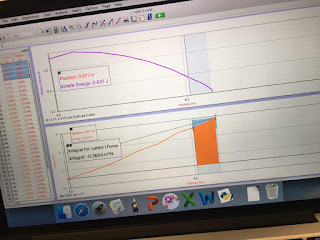1. Lab:
Ballistic Pendulum
a. Lab
conducted by Mohammed Karim (author)
2. Objective
– There were two objectives to this lab.
The first being to calculate the initial velocity that the bullet fires into
the box, and the second being to prove that the velocity is correct by using
the velocity to calculate the distance the ball will travel.
3. Theory/Introduction
– Knowing various concepts like projectile motion, energy, and momentum, can
help us accomplish even the most complex of problem. In this lab, we are tasked
with finding the initial velocity that the bullet fires into the box, given the
length of the “string” and the angle the box travels.
4. Apparatus/Procedure
–
The apparatus is pretty much a ready made
pendulum. We fired it multiple times, found the average theta, length of the “string”,
mass of the bullet, and mass of the box. We then solved for velocity initial of
the bullet, which turned out to be 4.837 m/s (See Figure 14.1 for
calculations). In order to put this answer to the test, we calculated the
distance it would travel before it hits the floor, using the velocity we
calculated. We first found time using h=1/2gt^2, and then plugged it into x=vt,
giving us 2.1945m. After firing the shot, we got around 2.35-2.43m (See Figure
14.2 for calculations)
5. Data
Tables
Figure 14.2 – Calculations of the distance of the bullet using projectile motion.
6. Conclusion
– Overall, our results were very accurate as our calculations were around 5
percent of our experiment. This is a victory in my book. Had there not been
many uncertainties, I would have been 100% correct. These uncertainties
include, rounding up values during the multiple calculations, air resistance,
uncertainty of force used when firing with the cannon, and uncertainty in
measurement of the height and distance the cannon was from the point of impact.
Had these little values been exact, I think my answer would have been much
closer, if not the same.

























